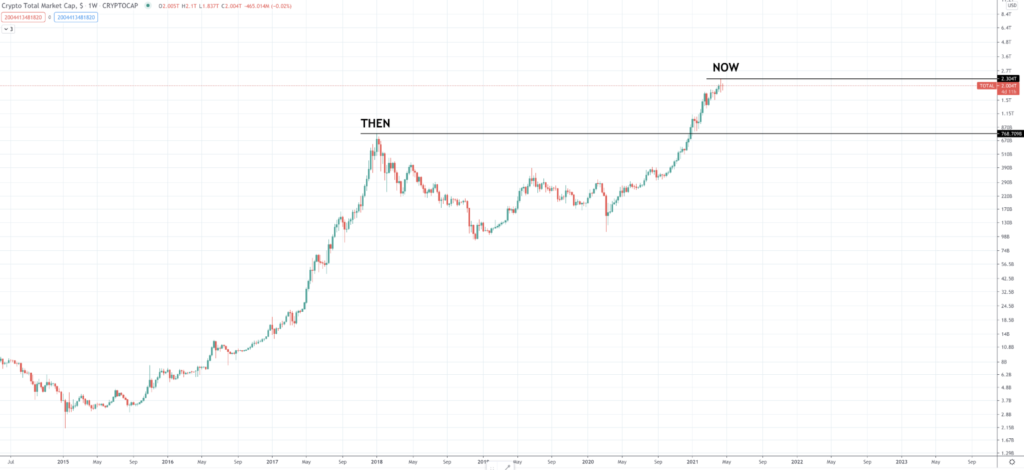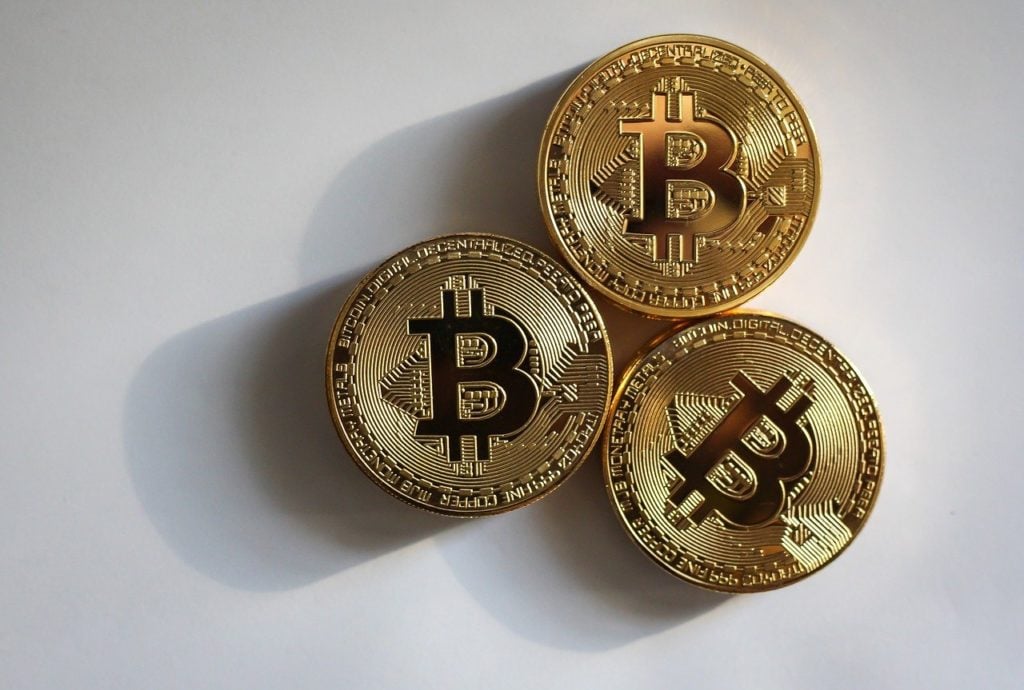If you have been around cryptocurrencies like Bitcoin and Ethereum for some time, chances are you have heard the term market cap discussed.
It is something that helps to measure the total worth of the Bitcoin network and all coins in circulation. The same is true for all cryptocurrencies. But now all market caps are created equal, and are some critical factors to pay attention to when coming up with such calculations and therefore valuations.
This in-depth guide breaks down all you need to know to fully understand cryptocurrency market caps, as well as how they compare to say the market cap of major stocks.
What Does Market Cap Mean In Crypto? Cryptocurrency Market Capitalization Defined
Market cap is a term often used to represent market capitalization for short, which is the sum of all coins currently in circulation multiplied by the total price per coin.
The market cap of cryptocurrencies are used to rank the popularity and success of the various coins across the market, the same way such metrics are used to value publicly traded companies.
The higher the rank, the more visibility and respect the coin garners as a result. Any coins in the crypto market top ten by market cap are essentially cemented as the crypto elite. These coins aren’t just the ones with high token velocity or hype, they’re ones with longevity and real future value.

How Is Crypto Market Capitalization Calculated?
The formula to calculate market cap in crypto assets is as follows:
Circulating supply of coins x price per coin = total crypto market capitalization
Diluted Cryptocurrency Market Cap Calculations
In traditional finance, a diluted market cap represents what a stock’s market cap would be if all stock options were exercised and all convertible notes were exchanged for stock.
Things in crypto are of course different, but follow a similar methodology. In this case, a fully diluted market cap in crypto is if the max supply of coins have been fully issued by the underlying protocol.
The formula to calculate diluted market cap in crypto assets is as follows:
Max supply of coins x price per coin = total diluted crypto market capitalization
Circulating Supply Versus Total Supply Versus Max Supply: What’s The Difference?
Every blockchain protocol is different, and issues coins at varying rates. The supply of each coin also is inconsistent depending on each platform’s goals.
Take Bitcoin for example. There are currently more than 18,000,000 BTC in circulation, out of a total 21 million BTC that will ever exist. The 18 million number is the circulating supply, while the total 21 million BTC is both the total supply and max supply.
Max supply is the total coins that will ever exist, but total supply can shrink in certain cases.
What Are Deflationary Tokens?
Deflationary tokens are cryptocurrencies with a total supply that is reduced through token burns. Token burns occur when a portion of tokens are sent to a burner address, inaccessible and with the intent of making sure coins don’t reenter the supply.
Blockchain’s distributed ledger technology makes this clear to all protocol participants. Lowering token supply improves the environment for price appreciation and provides long term value to token holders.
A great example of a deflationary token, is the COV utility token powering the Covesting copy trading platform. In addition to using the coin to unlock a variety of benefits, the Covesting team regularly burns tokens to reduce both circulating and total supply.
What Is The Total Crypto Market Cap?
The total market cap of cryptocurrency is an aggregation of the entire current market value across all altcoins and Bitcoin included. It is essentially an estimation of the valuation of the entire cryptocurrency industry.
As the cryptocurrency industry grows and prices increase so does the total crypto market cap. From just a billion market cap or less to nearly $1 trillion in 2017, to more than $2 trillion now in 2021, the total cryptocurrency capitalization has gone through several significant changes.

What Is Large-Cap, Mid-Cap, Small-Cap? The Difference In Cap Size Explained
Because market cap is a way to measure the success, size, and visibility of cryptocurrencies, they’re not just categorized into top ten, top twenty, and other data sets, but they’re also often down into the three following categories:
Large-Cap
Large-cap crypto assets are also called majors, and include the likes of XRP, Litecoin, and others higher up the ranks.
Mid-Cap
Somewhere in the middle of the crypto ranks, are the mid-caps. These coins are best known as Dogecoin, EOS, COV, and others.
Small-Cap
Small-cap coins are very small in market cap, but because of this could make for the best ROI with the most growth potential. Just beware if you invest that all capital coud be lost.
Is Total Market Capitalization Of Cryptocurrency Important?
It helps traders and investors alike choose which digital assets to focus their investment or trading capital, so it is a critical piece of information for all crypto market participants, analysts, and traders.
It tells the world clearly which coins demand the most capital and respect. The constant battle for the top ten brings each coin that makes the list more visibility and brand power.
Does Crypto Market Capitalization Show Its Popularity?
While social media buzz, online chatter, and other sentiment-focused metrics are best for popularity, in a sense market cap also works as a measure.
If a coin is popular, most likely money and capital is flowing into the asset and the price of the coin is increasing. If you follow the formula above, that means the total market cap will grow also.
What Is The Problem With Crypto Market Capitalization?
The problem with the crypto market cap is that coins come and go in popularity, it actually doesn’t do a great job of representing the long-term growth potential and value of each asset.
If you look back at historic snapshots of the crypto market top ten by market cap over the last decade, the coins that make the list regularly jump around. Even the coins in the top ten last year are completely different this year, making market cap far less effective in crypto than in stocks.
There’s also a major challenge due to liquidity. Because the supply of coins can often be locked up, there’s not enough supply to create sufficient liquidity for larger investors.
The Difference Between Stock Market and Crypto Market Capitalization
The difference between the stock market capitalization and crypto market capitalization is minimal from a calculation standpoint. Things only differ when you start talking shares versus coins.
Shares represent ownership in a company, while crypto assets are the underlying asset that underpins each blockchain protocol. Not all stock shares are offered, nor all coins are released from the protocol.
Stock shares can be split, and coins can be forked. The differences and similarities both are potentially endless.

Summing It All Up: Crypto Market Cap Recap And How To Get Started
This guide has gone in depth about all things crypto market cap. One key takeaway is that these highly volatile assets regularly fluctuate wildly, causing enormous price swings.
Without the proper risk management tools, an investor’s portfolio can be reduced to ashes. At Flurex Option, users can not only trade cryptocurrencies like Bitcoin, Ethereum, Litecoin, EOS, and XRP, they can protect their capital with stop loss orders, and other tools.
Built-in charting software helps traders plan and execute successfully. Covesting copy trading is available for those that struggle to get their footing as a new trader. It is no wonder why trading volume on the advanced platform has been breaking records during the recent crypto market bull run.
More than 50 different trading instruments are offered, ranging from forex, to commodities, stock indices, to crypto. There’s a four-level referral program, a helpful blog, and 24/7 customer service live chat.
Flurex Option recently launched a redesigned Flurex Option V2.0 update that introduced ETH and stablecoins next to BTC-based margin accounts. A new regulatory license means fiat currencies are also coming.
To learn more, get registered on Flurex Option.
What Is The Market Cap Of Cryptocurrency?
Market cap is a term often used to represent market capitalization for short, which is the sum of all coins currently in circulation multiplied by the total price per coin. It is often used to rank each coin’s popularity and the respect it has earned in the industry.
How Is Crypto Market Capitalization Calculated?
The formula to calculate involves multiplying the circulating supply of coins by the current price per coin. The sum is the total crypto market capitalization for that particular digital asset.
Is Market Cap Important In Cryptocurrency?
Because the higher the market cap, the more visibility each coin gets, it is especially important to each crypto. The closer each coin gets to Bitcoin and Ethereum, the more successful it is in the market.
What Was The Highest Crypto Market Cap?
The highest crypto market cap ever recorded is currently Bitcoin’s, reaching over $1 trillion at a full $1.18 trillion around the Coinbase Global stock market launch. The total crypto market cap’s highest ever was well over $2 trillion and is still climbing.
What Happens When A Cryptocurrency Reaches Max Supply?
When a cryptocurrency reaches its max supply, no further coins are issued by the blockchain protocol. At this point, the ecosystem would be self-sustaining through fees or another mechanism.
What's The Fastest Growing Cryptocurrency?
This is hard to say and is always changing. This week, it's Dogecoin. Before that it was DeFi tokens and Ethereun. Other times it is Bitcoin ripping. Right now crypto is on fire, so most coins are growing rapidly as is the total market cap.


